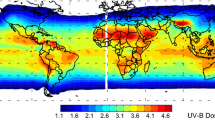Abstract
UsV measurements from instruments maintained by USDA at 16 mid-latitude sites were analysed to investigate geographic differences. Fifteen of the sites are in North America, and one is in New Zealand. The instruments measure erythemally weighted UV radiation, and the results are presented in terms of UV Index (UVI). The focus of this work is on data from 2003, but the main results are also shown for years 2002 and 2004. In the North American sites, the peak UVI values increase by ~15% between latitudes 47° N and 40° N, and they show an increase with altitude of ~15% in the first kilometer, but much smaller rates of increase above that level. Peak UV intensities in the New Zealand site (45° S, alt. 0.37 km) exceed those at comparable latitudes and altitudes in North America by 41 ± 5%, and are more comparable with those over 1 km higher and 5 degrees closer to the equator. The number of observations on these days that exceeded various thresholds of UVI showed similar patterns. Furthermore, the number of days in which the peak values exceeded various thresholds also showed similar patterns, with the number of extreme values in New Zealand being anomalously high. For example, the only sites in North America where UVI exceeded 12 were at the high altitude sites in Colorado and Utah, for which there were 53 days, 6 days and 2 days respectively at the 3.2 km, 1.6 and 1.4 km sites. By contrast, the peak UVI at Lauder (0.37 km) exceeded 12 on 17 days. Lauder was the only site under 1 km altitude where the UVI exceeded 11 on a regular basis (48 days). The optical depths at Lauder were significantly lower than at all North American sites. These, together with the lower ozone amounts and the closer Earth-Sun separation in summer all contribute to the relatively high UV intensities at the New Zealand site. Other sites in New Zealand show similar increases compared with corresponding sites in North America, and the differences persist from year to year. The contrast in UV between New Zealand and North America is similar to that observed previously between New Zealand and Europe. During winter months, the UVI in New Zealand is not particularly high, giving a larger summer/winter contrast in UVI, which may be important from a health perspective.
Similar content being viewed by others
References
D. S. Bigelow, J. R. Slusser, A. F. Beaubien and J. H. Gibson, The USDA ultraviolet radiation monitoring program Bull. Am. Meteorol. Soc. 1998 79 601–615.
2003 Annual Report of the USDA UV-B Monitoring and Research Program, ed. J. Slusser, B. Slusser and W. Gao, Colorado State University, Fort Collins, CO, 2003.
J. B. Liley and R. L. McKenzie, Air clarity implications for solar radiation at the surface, in 16th International Clean Air and Environment Conference, Clean Air Society of Australia and New Zealand (CASANZ), Christchurch, 2002, pp. 502–505.
R. McKenzie, B. Connor and G. Bodeker, Increased summertime UV radiation in New Zealand in response to ozone loss Science 1999 285 1709–1711.
G. Seckmeyer, B. Mayer, G. Bernhard, R. L. McKenzie, P. V. Johnston, M. Kotkamp, C. R. Booth, T. Lucas, T. Mestechkina, C. R. Roy, H. P. Gies and D. Tomlinson, Geographical differences in the UV measured by intercompared spectroradiometers Geophys. Res. Lett. 1995 22 1889–1892.
G. Seckmeyer and R. L. McKenzie, Increased ultraviolet radiation in New Zealand (45° S) relative to Germany (48° N) Nature 1992 359 135–137.
K. O. Lantz, P. Disterhoft, J. DeLuisi, E. A. Early, A. Thompson, D. Bigelow and J. Slusser, Methodology for deriving clear-sky erythemal calibration factors for UV broadband radiometers of the U.S. Central UV Calibration Facility J. Atmos. Oceanic Technol. 1999 16 1736–1752.
A. F. McKinlay and B. L. Diffey, A reference action spectrum for ultra-violet induced erythema in human skin, in Human Exposure to Ultraviolet Radiation: Risks and Regulations, ed. W. F. Passchier and B. F. M. Bosnajakovic, Elsevier, Amsterdam, 1987, pp. 83–87.
G. Seckmeyer, A. Bais, G. Bernhard, M. Blumthaler, C. R. Booth, K. Lantz and R. L. McKenzie, Instruments to measure solar ultraviolet irradiance. Part 2: Broadband instruments measuring erythemally weighted solar irradiance, Global Atmosphere Watch Report No. 164, World Meteorological Organisation, Geneva, 2004, WMO TD No. 1289, available from the WMO web site in draft form (see http://www.wmo.ch/web/arep/gaw/gawreports.html), p. 30.
G. E. Bodeker, J. C. Scott, K. Kreher and R. L. McKenzie, Global ozone trends in potential vorticity coordinates using TOMS and GOME intercompared against the Dobson network: 1978-1998 J. Geophys. Res. 2001 106 23029–23042.
R. L. McKenzie, P. V. Johnston, D. Smale, B. Bodhaine and S. Madronich, Altitude effects on UV spectral irradiance deduced from measurements at Lauder, New Zealand and at Mauna Loa Observatory, Hawaii J. Geophys. Res. 2001 106 22845–22860.
L. Harrison, J. Michalsky and J. Berndt, Automated multifilter rotating shadow-band radiometer: an instrument for optical depth and radiation measurements Appl. Opt. 1994 33 5118–5125.
L. J. B. McArthur, D. H. Halliwell, O. J. Niebergall, N. T. O’Neill, J. R. Slusser and C. Wehrli, Field comparison of network Sun photometers J. Geophys. Res. 2003 108 4596. 4510.1029/2002JD002964
T. Green, M. Skeaff and J. Rockwell, Serum 25-hydroxyvitamin D status of New Zealand adolescents and adults 15 years and older: results of the 1997 national nutrition survey Osteoporosis Int. 2005, submitted.
A. R. Webb, L. Kline and M. F. Holick, Influence of season and latitude on the cutaneous synthesis of vitamin D3: Exposure to winter sunlight in Boston and Edmonton will not promote vitamin D3 synthesis in human skin J. Clin. Endocrinol. Metab. 1988 67 373–378.
Author information
Authors and Affiliations
Rights and permissions
About this article
Cite this article
McKenzie, R., Bodeker, G., Scott, G. et al. Geographical differences in erythemally-weighted UV measured at mid-latitude USDA sites. Photochem Photobiol Sci 5, 343–352 (2006). https://doi.org/10.1039/b510943d
Received:
Accepted:
Published:
Issue Date:
DOI: https://doi.org/10.1039/b510943d



